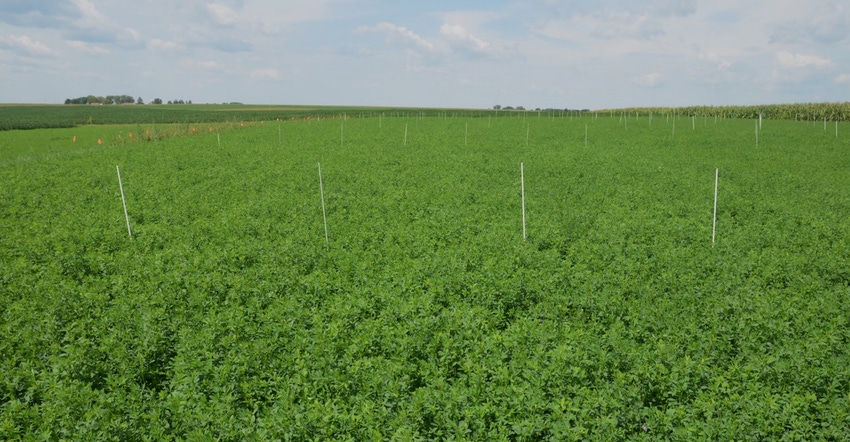November 10, 2020

When comparing factors affecting dollar return per acre for alfalfa, yield is still No. 1, followed by stand persistence and forage quality. In recent years an increasing number of hay producers have questioned me about various inputs to improve yield. Alfalfa production has been challenging lately with two very wet seasons in 2018 and 2019, and now a droughty summer in 2020, but let’s not lose sight of best management practices for greatest economic return.
Over the past 20 years, I’ve conducted numerous alfalfa production trials at the ISU Northeast Research Farm with macro (phosphate and potash), secondary (sulfur and calcium) and micro (boron, zinc and manganese) nutrients. I’ve also studied and tested the use of lime, foliar insecticides, fungicides and other products.
Included among this research is a three-year trial that I think best summarizes management practices we should apply. The trial had eight different treatments, allowing for multiple comparisons to assess their effects on yield, quality, stand persistence and overall economic return.
Aiming for high yields
The research was designed as a “high yield” alfalfa production trial with additive inputs. The stand was harvested four times a season starting in late May and cutting at 30- to 35-day harvest intervals. For the three-year trial, the base treatment averaged 21.3 tons per acre of dry matter alfalfa produced, while the treatment with the highest yield averaged 23.3 tons per acre dry matter. At 15% moisture hay, this equals 27.1 tons per acre for three years, or an average of 9 tons per acre per year for the trial.
In preparation for the establishment year and during that first season, the research site was carefully adjusted to achieve a soil pH of 6.9 to 7.0, and soil test P and K levels to be within ISU’s recommended optimum range for alfalfa production. Sulfur fertilizer was also applied to all plots every year based on results from previous trials at the farm. Best management establishment practices were followed to achieve a uniform stand. By spring of the next year, the stand density measured an average of 20 plants per square foot across all plots and was ready for treatment applications for the next three years.
Treatments included:
• 100% Iowa State University fertilizer rate plus insecticide, which basically equates to fertilizing for crop removal when soil tests fall within the optimal range
• 100% rate plus insecticide plus foliar fertilizer
• 125% fertilizer rate plus insecticide
• 125% rate plus insecticide plus foliar fertilizer
• 125% rate plus foliar fertilizer but without insecticide
• 125% rate plus insecticide plus foliar fertilizer plus Bioforge
• 125% rate plus insecticide plus foliar fertilize plus foliar fungicide
• 125% rate plus insecticide plus foliar fertilize plus foliar fungicide plus Bioforge
Most economical treatment?
The results of the three-year trial supported what similar previous trials have found. The 100% fertilizer rate was the most economical of the fertilizer treatments. The 125% rate cost an additional $41.20 per acre per season and only produced 0.3-ton higher yield for the entire trial, for a three-year net loss of $73.80 per acre compared to the 100% fertilizer rate. The foliar fertilizer treatments did not increase alfalfa yield or quality resulting in a three-year net loss of $29 per acre.
Foliar insecticide treatments managed to increase yield by 0.7 ton per acre over the entire trial which provided a three-year net profit of $44 per acre, but the applications were made regardless of insect pressure. If the treatment would have been based on scouting and economic threshold, the treatment would have been more profitable. No benefit in yield or forage quality was found with the Bioforge applications.
Foliar fungicide was applied for first, second and third crops each year and increased yields all three years by an average of 8%. This provided a three-year net profit of $118. However, yield response was best with first crop treatments, while the other treatments were either not economically significant or resulted in a net loss, and none of the treatments improved forage quality.
Fertilizer and winter injury
Another interesting aspect of the trial included the stand being exposed at the end of the second year to a hard winter, which caused significant stand loss. Stem counts dropped from 55 per square feet in the second year to 38 per square feet in the third year; however, there was no difference in stand loss for the different treatments. Neither higher fertilizer rates nor fungicide applications shielded the stand from winter injury relative to the other treatments.
Keep in mind that improved winter-hardiness and disease resistance of new varieties continue to enhance alfalfa’s ability to grow and survive difficult conditions. Variety choice and cutting management at the end of the growing season are important to help avoid or minimize winter injury and stand loss.
The bottom line
The best strategy for achieving “most profitable” alfalfa production is to maintain normal ISU soil fertility recommendations, apply foliar insecticide based on economic threshold, and apply foliar fungicide at the most opportune windows such as for the first crop and other significantly wet environments. Overfertilization is costly, as it would be for underfertilization, and applying bells-and-whistles still doesn’t improve profitability.
Lang is the ISU Extension field agronomist at Decorah in northeast Iowa. Email [email protected].
Read more about:
AlfalfaAbout the Author(s)
You May Also Like






